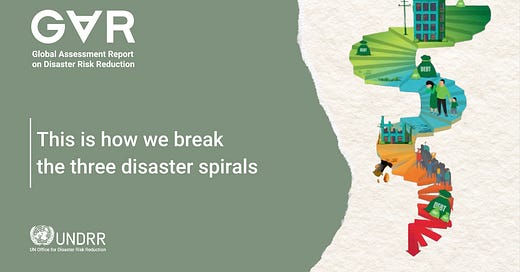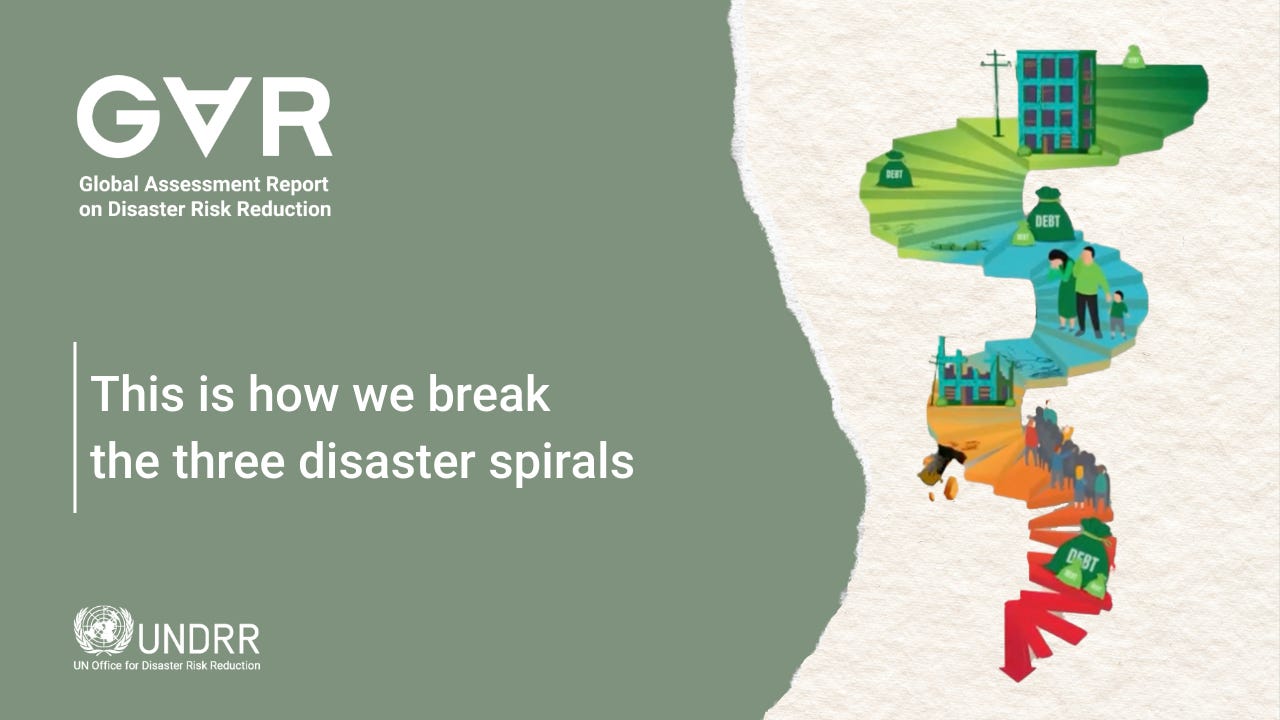When I was building my sustainability communication project at Columbia University, I was recruited to be an author of a chapter on “communicating risk for decision-making” in what would become the 2022 Global Assessment Report from the United Nations Office for Disaster Risk Reduction. I couldn’t participate fully in the end (boring reasons) but gained a valuable view of the depth and breadth of expertise brought together by these periodic reports. Explore some of the results here:
The pandemic, which exploded as the writing process played out, vividly illustrated how all the communication advice in the world comes to naught if no one heeds it. But the world is still better with these efforts than it would be without them.
The 2025 report is being launched today. I hope you can spare at least a little time to listen to my conversation with Kamal Kishore, who leads that office and was previously the head of India’s National Disaster Management Authority of India. Back then he led the G20 Working Group on Disaster Risk Reduction and contributed to the development of the Coalition for Disaster Resilient Infrastructure.
Here’s the report description:
The Global Assessment Report (GAR) 2025: Resilience Pays: Financing and Investing for our Future highlights how smarter investment can reset the destructive cycle of disasters, debt, uninsurability and humanitarian need that threatens a climate-changed world.
Disaster risk is increasing as more frequent and intense hazard events, unsafe urbanisation, and ineffective development put more people and assets in harm's way. Disasters have profound macroeconomic impacts, with direct losses estimated at $202 billion. When cascading and ecosystem costs are taken into account, escalating disaster costs now surpass $2.3 trillion annually.
There is an urgent need to transform how disaster risk is addressed amid a rapidly changing climate. Risk is no longer a peripheral issue but a systemic challenge that affects financial stability, sustainability, and equity. By embedding risk reduction into core policy and investment decisions, it is possible to break the recurring cycle of shocks, losses and debt. With the right choices, resilience can become a foundation for long-term prosperity, enabling societies not only to withstand disasters but to thrive despite them.
I recorded the conversation above ahead of time because my wife and I (if travel chaos didn’t interfere) are currently in Athens on a rare international trip that doesn’t have my work at its core.
The United Nations is as flawed as any bureaucracy, but my experience made me ever more convinced it has a vital role to play as the world’s nations and communities grapple with grand challenges.
This 2022 Sustain What conversation on how to get news media to focus more on the conditions that turn a hard knock into a disaster couldn’t be more relevant:
When Avoiding Disaster is the Story
By their nature, news media focus on events, victims and villains more than the social systems that, through neglect or sometimes malice, lead to the calamitous losses we call disasters.
Is there a way to make preparedness and risk reduction the story? And is there a way to have that story read, and acted on?
In this special Sustain What webcast, veteran journalist Andy Revkin of the Columbia Climate School explores challenges and innovations with journalists and experts, several of them in Bali, Indonesia, for the United Nations Global Platform for Disaster Risk Reduction.
The theme is "From Risk to Resilience: Towards Sustainable Development for All in a COVID-19 Transformed World." Here's the Global Platform site: https://globalplatform.undrr.org
My guests were:
Mavic Conde, an independent environmental journalist in the Philippines focused on solutions reporting.
https://twitter.com/condemavic
Joshua L. DeVincenzo, researcher and adjunct lecturer at the Columbia Climate School’s National Center for Disaster Preparedness (NCDP)
https://twitter.com/j_devincenzo
Natalia Ilieva, Head of the office of the Secretary Genera of the Asia-Pacific Broadcasting Union
https://www.linkedin.com/in/natalia-ilieva-360a7324
Roger Pulwarty, NOAA Physical Sciences Laboratory Senior Scientist and a Global Assessment Report author https://psl.noaa.gov/people/roger.pulwarty/
And here’s “disasterologist”
explaining why vulnerability imbalances created by corporate power, marginalization, racism and other social dynamics need to be recognized and acted on:Amid a Barrage of Climate Calamities, "Disasterologist" Samantha Montano Puts the Focus on Disaster [In]Justice
UPDATED post show: Given this year’s continuing string of unnatural disasters, a late-season hurricane poised to be a threat in the Gulf of Mexico, and the incoming Trump administration seemingly deadset on disrupting the Federal Emergency Management Agency and National Oceanic and Atmospheric Administration, it’s high time to visit with a disaster poli…







![Amid a Barrage of Climate Calamities, "Disasterologist" Samantha Montano Puts the Focus on Disaster [In]Justice](https://substackcdn.com/image/fetch/$s_!YaXt!,w_1300,h_650,c_fill,f_auto,q_auto:good,fl_progressive:steep,g_auto/https%3A%2F%2Fsubstack-post-media.s3.amazonaws.com%2Fpublic%2Fimages%2F6f39a4e3-29c5-427a-b1f5-5eafce7b264b_1664x1462.jpeg)








Share this post